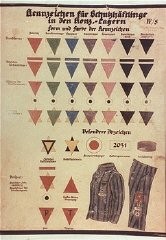How the Nazis persecuted LGBTQ people
By Erica Nadelhaft, HHRC Northern Maine Educator and Holocaust and Anti-Semitism Scholar
The Nazi code of racial hierarchy, enshrined in the Nuremberg Laws of 1935, set the stage for the extermination of the Jews and the persecution and murder of many other groups that the Nazis deemed racially unfit. These included Poles, Slavs, Sinti and Roma (gypsies), mentally and physically handicapped Germans, those with hereditary diseases, and homosexuals.
Homosexuality between men had been illegal in Germany since the unification of the country in 1871. In 1935, the Nazis broadened interpretation of the law to include not just intercourse between men, but any and all sexual behavior, even simple looking or touching of a sexual nature. The following year, Himmler created the Reich Central Office for Combatting Homosexuality and Abortion to help track and arrest those suspected of homosexuality. Prior to the outbreak of World War II in September, 1939, over 75,000 men were arrested. Some were committed to mental institutions; some underwent voluntary castration to stay out of prison; and others were imprisoned.
The pace of imprisonment for homosexuality increased after the war began. In July, 1940, Himmler decreed that the Criminal Police could send any imprisoned homosexual known to have had more than one partner could be sent directly to a concentration camp following their release from prison. By the end of November, 1942, concentration camp commandants had the right to order the castration of any imprisoned homosexual. The following year the Nazis instituted an explicit program of “extermination through work” as a means to destroy habitual criminals, including homosexuals, in the concentration camp system. Close to 15,000 homosexuals were moved from regular prisons to concentration camps, were most of them died within a few months.

Nazi Classification System Source: USHMM
Concentration camp prisoners were differentiated from one another using a system of colored triangles. Jewish prisoners had a yellow star sewn onto their uniforms beginning in 1938. By 1939, concentration camps had adopted a system of colored inverted triangles and letters to identify the types of prisoners in the camps. Letters were added to specify which country a non-German prisoner came from. Homosexual prisoners wore a pink triangle on their uniforms. If a prisoner was both homosexual and Jewish, a pink inverted triangle would be superimposed over a regular yellow one. This system allowed camp guards and other prisoners to instantly identify where an inmate came from and what type of prisoner he was.
Because homosexual prisoners in the concentration camps were distinguished from other prisoners by the pink triangles they wore on their uniforms, they were easily identifiable and were subject to physical and sexual abuse by both camp guards and other prisoners.
After the end of the war, the law against homosexuality remained in force, and many homosexuals had to serve out their remaining prison time even after surviving the concentration camps. They were denied compensation as victims of Nazism. Homosexual relations between men over 21 were not decriminalized in Germany until 1969 and the law forbidding homosexuality was not abolished until 1994. In 2002 the German parliament finally pardoned homosexuals convicted by the Nazis.
